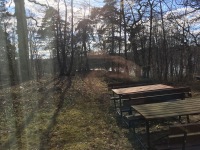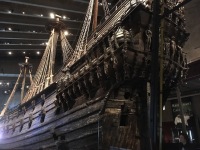The weather has turned, and I can breathe again. I'm not happy in hot weather (for hot, read over 26°C) and this summer has for basically all of July and half of August been around 28-30°C. All my plans for summer were scrapped, as there was only enough functioning brain to re-read simple books and even then only for short moments each day.
The good news is that I did so much in late spring/early summer that there will undoubtedly be material for several posts. (the bad news is that autumn will be very busy and my supervisor insists that I must write on my actual thesis.)
As always, click on the images to see them in proper size.
In the end of April I went to Stockholm for the second Nordic ZooArch meeting, held at the Archaeology department of the university. I took the night train, thereby being able to go to the research seminar that my department had that afternoon, and I saved a bit of money on hotel rooms, which is always a bonus. The drawback is that you arrive in Stockholm at 6am, and I’m not a morning person. But with a meeting start at 10am, there was plenty of time for a slow wake-up (you have until 7am to leave the train), leisurely breakfast and sorting out a travel card for the metro/buses.
The archaeology department is set a bit apart from the main campus. The drawback is that it’s further to walk if you want to buy lunch, but on the other hand they have a great view over a small lake and much more nature (including roe deer in the woods) than the rest of the campus.

Not a bad place for your lunch or afternoon fika...
Danish, Swedish and Norwegian are mainly mutually intelliglible (barring strong regional accents) and on the previous meeting everyone spoke their own language. The official languages on this meeting included English, since now we had a few Finnish participants. In Finland you have to learn Swedish in school, since it’s officially a bilingual country, but as with such things, if you are forced to do something and have no incentive to learn and to keep it up (say, if you don’t live in a Swedish speaking area), you tend to forget most of it. So one can’t assume that Finns will be able to follow an academic talk in Swedish (or for that matter, Danish).
The talks were very diverse, ranging from Mesolithic fur animals to Medieval waste management; from 19th century fish oil production to the historical/cultural history of goats in Finland; from animal keeping on early Medieval central places to fish fermenting in the Mesolithic. We also discussed how to manage collections and decided that we wanted to make a reference collection database, so we can find out where a specific species can be found in case we need to use it for comparison. A similar database has just been launched in the UK: The National Zooarchaeological Reference Resource, and I’ve had much use of it already, trying to find calf mandibles (but that’s another story for another day).
After the two-day conference I had a Sunday off, and decided to be a tourist and see the Vasa. It’s a fantastic ship, but unfortunately you only see it from the outside – not even a model to show what the interior looks like. And since she sank on the maiden voyage (1628), there were relatively few items on board. Contrast this to the Mary Rose (1545), where we have so many finds, but only half the ship. I also went to the open-air museum/Nordic zoo Skansen for the first time. It was very early in the season, so few houses were open to the public. But still, a nice day out.

The Vasa from below

The Vasa from above
Monday was back to PhD-ing, but this time in Stockholm. I met up with the people at the National Archive who has helped me with sampling of the parchment charters and went to the Royal Library to have a look at some books and articles. Tuesday I took the train to Uppsala to meet with a conservator at the University Library trying to convince them to do some sampling for me (spoiler: I succeeded!). Since it was my first time in Uppsala I also did some touristing of the Gustavianum museum and the Cathedral. Not my favourite cathedral, but it has the 16th century Sture garments! No photos of those, since there are lots on the internet and besides, the interesting bit is the construction and I can get that from books. Wednesday was again an early start, when I left Stockholm for home, stopping in Linköping on the way to sample some books and charters in the diocese library.
All in all a good couple of days, but quite intense!

The Old Town in Stockholm by night
The good news is that I did so much in late spring/early summer that there will undoubtedly be material for several posts. (the bad news is that autumn will be very busy and my supervisor insists that I must write on my actual thesis.)
As always, click on the images to see them in proper size.
In the end of April I went to Stockholm for the second Nordic ZooArch meeting, held at the Archaeology department of the university. I took the night train, thereby being able to go to the research seminar that my department had that afternoon, and I saved a bit of money on hotel rooms, which is always a bonus. The drawback is that you arrive in Stockholm at 6am, and I’m not a morning person. But with a meeting start at 10am, there was plenty of time for a slow wake-up (you have until 7am to leave the train), leisurely breakfast and sorting out a travel card for the metro/buses.
The archaeology department is set a bit apart from the main campus. The drawback is that it’s further to walk if you want to buy lunch, but on the other hand they have a great view over a small lake and much more nature (including roe deer in the woods) than the rest of the campus.

Not a bad place for your lunch or afternoon fika...
Danish, Swedish and Norwegian are mainly mutually intelliglible (barring strong regional accents) and on the previous meeting everyone spoke their own language. The official languages on this meeting included English, since now we had a few Finnish participants. In Finland you have to learn Swedish in school, since it’s officially a bilingual country, but as with such things, if you are forced to do something and have no incentive to learn and to keep it up (say, if you don’t live in a Swedish speaking area), you tend to forget most of it. So one can’t assume that Finns will be able to follow an academic talk in Swedish (or for that matter, Danish).
The talks were very diverse, ranging from Mesolithic fur animals to Medieval waste management; from 19th century fish oil production to the historical/cultural history of goats in Finland; from animal keeping on early Medieval central places to fish fermenting in the Mesolithic. We also discussed how to manage collections and decided that we wanted to make a reference collection database, so we can find out where a specific species can be found in case we need to use it for comparison. A similar database has just been launched in the UK: The National Zooarchaeological Reference Resource, and I’ve had much use of it already, trying to find calf mandibles (but that’s another story for another day).
After the two-day conference I had a Sunday off, and decided to be a tourist and see the Vasa. It’s a fantastic ship, but unfortunately you only see it from the outside – not even a model to show what the interior looks like. And since she sank on the maiden voyage (1628), there were relatively few items on board. Contrast this to the Mary Rose (1545), where we have so many finds, but only half the ship. I also went to the open-air museum/Nordic zoo Skansen for the first time. It was very early in the season, so few houses were open to the public. But still, a nice day out.

The Vasa from below

The Vasa from above
Monday was back to PhD-ing, but this time in Stockholm. I met up with the people at the National Archive who has helped me with sampling of the parchment charters and went to the Royal Library to have a look at some books and articles. Tuesday I took the train to Uppsala to meet with a conservator at the University Library trying to convince them to do some sampling for me (spoiler: I succeeded!). Since it was my first time in Uppsala I also did some touristing of the Gustavianum museum and the Cathedral. Not my favourite cathedral, but it has the 16th century Sture garments! No photos of those, since there are lots on the internet and besides, the interesting bit is the construction and I can get that from books. Wednesday was again an early start, when I left Stockholm for home, stopping in Linköping on the way to sample some books and charters in the diocese library.
All in all a good couple of days, but quite intense!

The Old Town in Stockholm by night